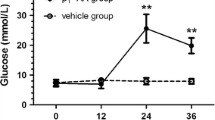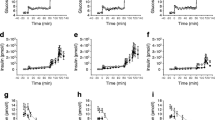Abstract
Little is known about the receptor and post receptor mechanisms of sympathoadrenal signal transmission in type I diabetes mellitus. Therefore, we examined the maximum binding of granulocyte β2-adrenoceptors and the in vitro c-AMP accumulation in lymphocytes of 24 children and adolescents with diabetes mellitus and 14 similarly aged healthy subjects. The number of high affinity β2-adrenoceptors on granulocytes correlated significantly with unstimulated (r=0.6,P<0.004) and with isoproterenol stimulated c-AMP values in lymphocytes (r=0.68,P<0.0007) showing the proportional changes of β2-adrenoceptors and c-AMP in two different cells. The number of β2-adrenoceptors on granulocytes was significantly reduced in diabetic as compared to healthy children (median 1397, range 599–3405 vs. 2205, 825–3200 β2-adrenoceptors per granulocyte,P=0.014). Moreover, the percentage in vitro stimulation of c-AMP by isoproterenol in lymphocytes was significantly reduced in diabetic children as compared to healthy individuals (120%, 39%–278% vs. 225%, 66%–500%,P=0.012). These results indicate a decreased sympathoadrenergic signal transmission in peripheral blood cells as a model for the liver probably contributing to severe hypoglycaemia in diabetic children.
Similar content being viewed by others
Abbreviations
- Bmax :
-
maximum binding
- c-AMP:
-
cyclic adenosine monophosphate
- KD:
-
ligand-receptor-complex
References
Amiel SA, Simonson DC, Shewin RS, Lauitano AA, Tamborlane WV (1987) Exaggerated epinephrine responses to hypoglycaemia in normal and insulin-dependent diabetic children. J Pediatr 110: 832–837
Anhäupl T, Liebel B, Trunk E, Ensinger H, Träger K, Georgieff M (1993) Evidence for the inverse relation of high and low affinity binding sites for (-)125iodocyanopindolol in human mononuclear leucocytes during epinephrine infusion. J Recept Res 13: 355–367
Arner P, Engfeldt P, Hellström L, Lönnqvist F, Wahrenberg H, Sonnenfeld T, Brönnegard M (1990) β-adrenoreceptor subtype expression in human liver. J Clin Endocrinol Metab 71: 1119–1126
Berlin I, Grimaldi A, Landault C, Zoghbi F, Thervet F, Puech AJ, Legrand JC (1988) Lack of hypoglycemic symptoms and decreased β-adrenergic sensitivity in insulin-dependent diabetic patients. J Clin Endocrinol Metab 66: 273–278
Bevilacqua M, Vago T, Norbiato G, Chebat E, Baldi G, Meroni R, Regalia E (1987) Identification and characterisation of alpha1-and beta2-adrenergic receptors in human liver. Eur J Clin Invest 17: 320–325
Bolli G, De Feo P, Compagnucci P, Cartechnini M, Angeletti G, Santeusanio F, Brunetti P, Gerich JE (1983) Abnormal glucose counterregulation in insulin dependent diabetes mellitus. Diabetes 32: 134–141
Bolli G, De Feo, P, De Cosmo S, Perriello G, Ventura MM, Massi-Benedetti M, Santeusanio F, Gerich JE, Brunetti P (1984) A reliable and reproducible test for adequate glucose counterregulation in type I diabetes mellitus. Diabetes 33: 732–737
Brodde OE, Daul A, O'Hara N (1985) Terbutaline-induced desensitisation of human lymphocyte beta2-adrenoceptors. J Clin Invest 76: 1096–1101
Clutter WE, Rizza RA, Gerich JE, Cryer PE (1988) Regulation of glucose metabolism by sympathochromaffin catecholamines. Diabetes Metab Rev 4: 1–15
Conolly ME, Greenacre JK (1977) The β-adrenoreceptor of the human lymphocyte and human lung parenchyma. Br J Pharmacol 59: 17–23
Cryer PE (1992) Iatrogenic hypoglycemia as a cause of hypoglycemia-associated autonomic failure in IDDM. A Vicious cycle. Diabetes 41: 255–260
Cryer PE, White NH, Santiago JV (1986) The relevance of glucose counterregulatory systems to patients with insulin-dependent diabetes mellitus. Endocr Rev 7 (2): 131–139
Daneman D, Frank M, Perlman K, Tamm J, Ehrlich R (1989) Severe hypoglycaemia in children with insulin-dependent diabetes mellitus: frequency and predisposing factors. J Pediatr 115: 681–685
Dornan TL, Peckar CO, Mavon-White VA, Knight AH, Moore RA, Hockady TDR, Bron AJ, Turner RC (1981) Unsuspected hypoglycemia, hemoglobine A1 and diabetic control. Quart J Med 197: 31–38
Ferrante A, Thong YH (1980) Optimal conditions for stimultaneous purification of mononuclear and polymorphonuclear leucocytes from human blood by the HYPAQUE-FICOLL-method. J Immunol Methods 36: 109–117
Galant SP, Allred S (1981) Binding and functional characteristics of beta-adrenergic receptors in the intact neutrophil. J Lab Clin Med 98: 227–237
Gale E, Tattersall R (1979) Unrecognized nocturnal hypoglycaemia in insulin treated diabetics. Lancet I: 1049–1052
Gerich JE, Campbell PJ (1988) Overview of Counterregulation and its Abnormalities in Diabetes mellitus and other conditions. Diabetes Metab Rev 4 (2): 93–111
Gerich JE, Langlois M, Noacco C, Karam JH, Forsham PH (1973) Lack of glucagon response to hypoglycemia in diabetes: evidence for an intrinsic pancreatic alpha cell defect. Science 182: 171–173
Hirsch BR, Shamoon H (1987) Defective epinephrine and growth hormone response in type I diabetes are stimulus specific. Diabetes 36: 20–26
Hoffmann JP, Singer-Granick C, Drash AL, Becker DJ (1991) Plasma catecholamine responses to hypoglycemia in children and adolescents with IDDM. Diabetes Care 14: 81–88
Kawai Y, Powell A, Arinze IJ (1986) Adrenergic receptors in human liver plasma membranes: predominance of beta2 and alpha1-receptor subtypes. J Clin Endocrinol Metab 62: 827–832
Lefkowitz RJ, Hausdorff WP, Caron MG (1990) Role of phosphorylation in desensitisation of β-adrenoceptor. Trends of Pharmacol Sci 11: 190–194
Noji T, Tashiro M, Yagi H, Nagashima K, Suzuki S, Kuroume T (1986) Adaptive regulation of β-adrenergic receptors in children with insulin dependent diabetes mellitus. Horm Metab Res 18: 604–606
Otto J, Günther S, Urbaneck R (1990) The effects of theophylline on β2-adrenoceptors on polymorphonuclear leucocytes of asthmatic children and juveniles. Eur J Pediatr 149: 661–664
Reinhardt D (1989) Adrenoceptors and the lung: their role in health and disease. Eur J Pediatr 148: 286–293
Scatchard G (1949) The attractions of proteins for small molecules and ions. Ann NY Acad Sci 660–672
Serusclat P, Rosen GS, Smith EB, Shah SD, Clutter WE, Cryer PE (1983) Mononuclear leukocyte β2-adrenergic receptors and adenylate cyclase sensitivity in insulin-dependent diabetes mellitus. Diabetes 32: 825–829
Van Tits LJH, Michel MC, Grosse-Wilde H, Happel M, Eigler FM, Soliman A, Brodde OE (1990) Catecholamines increase lymphocyte β2-adrenergic receptors via a β2-adrenergic spleendependent process. Am J Physiol 258: E191–202
White NH, Skor DA, Gryer PE, Levandoski LA, Bier DM, Santiago JV (1983) Identification of type I diabetic patients at increased risk for hypoglycaemia during intensive therapy. N Engl J Med 308: 485–491
Author information
Authors and Affiliations
Rights and permissions
About this article
Cite this article
Schwab, K.O., Bartels, H., Martin, C. et al. Decreased β2-adrenoceptor density and decreased isoproterenol induced c-AMP increase in juvenile type I diabetes mellitus: An additional cause of severe hypoglycaemia in childhood diabetes?. Eur J Pediatr 152, 797–801 (1993). https://doi.org/10.1007/BF02073373
Received:
Accepted:
Issue Date:
DOI: https://doi.org/10.1007/BF02073373




